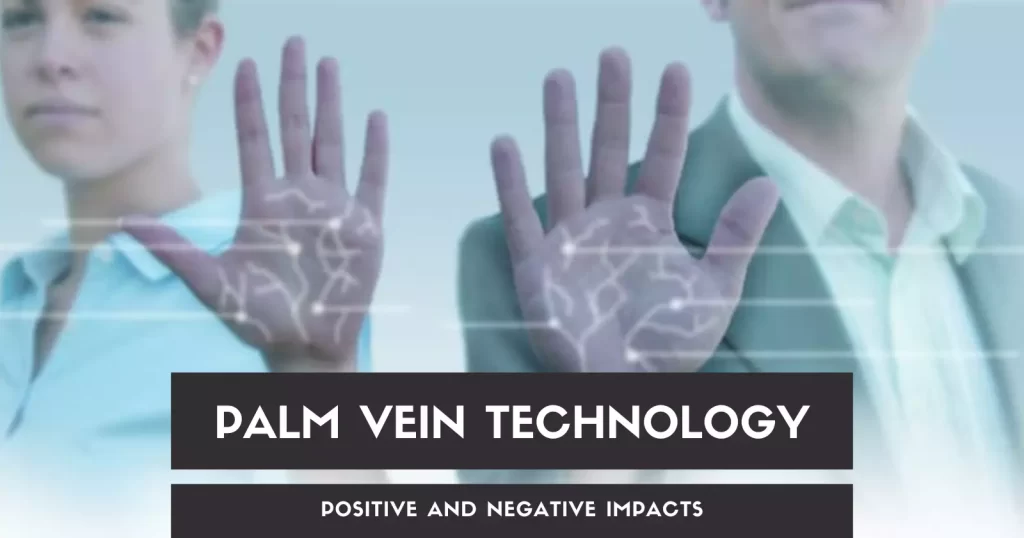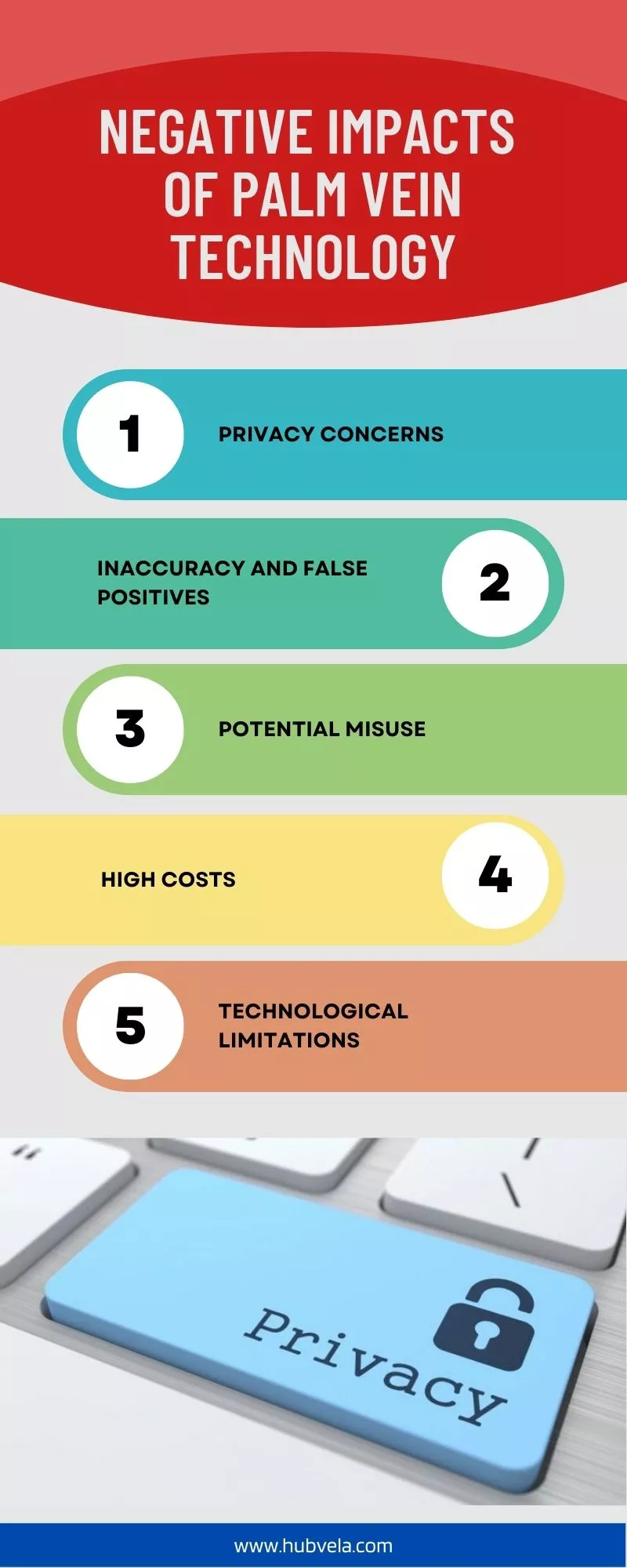Palm vein technology is a biometric authentication system that uses the unique vascular patterns in an individual’s palm to verify their identity.
This contactless technology has gained popularity in recent years due to its convenience and high level of security.
However, like any technology, it has both positive and negative impacts.
In this article, we will explore the positive and negative impacts of palm vein technology and its applications in various industries.

--Advertisement--
Positive Impacts of Palm Vein Technology:
Palm vein technology has several positive impacts, including high levels of security and privacy, accuracy in patient identification, and ease of use.
Palm vein recognition technology is ideal for identifying patients across a wide range of demographics.
The procedure is fast and easy, and the equipment is small and portable. The measurement results are not affected by the state of the hand’s surface.
Using biometric technology for identification works well for patients, clinicians, and the registration staff.
Let’s discuss some of the positive impacts of palm vein technology.

1. Enhanced Security
Palm vein technology has brought about enhanced security measures in various industries.
With its unique and complex biometric authentication system, it has become increasingly difficult for unauthorized individuals to gain access to secure areas or sensitive information.
This technology has proven to be highly effective in preventing identity theft, fraud, and other security breaches.
The positive impact of palm vein technology on security cannot be overstated, as it has provided a reliable and efficient means of ensuring that only authorized individuals have access to restricted areas or information.
As a result, businesses and organizations can operate with greater confidence, knowing that their assets and sensitive information are well-protected.
2. Contactless Authentication
Contactless authentication using palm vein technology has numerous positive impacts. Firstly, it provides a secure and reliable method of biometric identification with a low false acceptance rate.
Secondly, it eliminates the need for physical contact, making it a hygienic option in a post-pandemic world.
Additionally, palm vein authentication is unique, stable, and non-intrusive, making it an ideal choice for various applications.
The technology is also difficult to duplicate, as vein information is internal to the human body.
Overall, contactless authentication using palm vein technology offers a high level of accuracy and security, making it a promising solution for various industries.
3. Improved Medical Diagnosis
Palm vein technology has brought about positive impacts in the medical field, particularly in the area of improved medical diagnosis.
With the integration of palm vein technology into electronic health records (EHRs), patient information can be easily aggregated, analyzed, and communicated.
It makes it easier for healthcare providers to consider all aspects of a patient’s condition and support diagnostic and therapeutic decision-making.
Additionally, the use of artificial intelligence (AI) in medical imaging analysis, which can be facilitated by palm vein technology, has the potential to improve diagnostic quality and safety.
As technology continues to advance, careful consideration must be given to how it can be integrated into clinical diagnostic processes to ensure that it improves patient outcomes and safety.
4. Increased Efficiency
The use of palm vein technology has increased efficiency in identifying patients accurately and quickly.
This technology uses invisible infrared light to detect blood flowing through patients’ veins and creates digital signatures that are stored in the health system’s computer.
This not only saves time but also reduces errors in patient identification, leading to better patient outcomes.
Additionally, palm vein recognition has high security, liveness-detection, user acceptability, and convenience.
The positive impact of palm vein technology on society is undeniable, and its implementation in various sectors has led to increased efficiency and improved outcomes.
5. Access Control
Access control is an essential aspect of security systems, and palm vein technology has brought about positive impacts in this area.
Palm vein recognition systems are contactless, making them more hygienic and convenient to use.
Additionally, palm vein recognition is highly secure, as it uses the network of blood vessels underneath the palm skin for recognition, making it difficult to forge or replicate.
This technology has been used in healthcare to accurately identify patients, reducing the risk of medical errors and improving patient safety.
Compared to other biometric identification methods, palm vein authentication has a broader and more complex pattern, making it more unique and reliable.
The procedure is fast, easy, and has high levels of security and privacy, making it an ideal solution for access control in various settings.
Overall, palm vein technology has brought about positive impacts in access control, improving security, convenience, and accuracy.
Negative Impacts of Palm Vein Technology:
Palm vein technology has several advantages, such as high security and accuracy in recognizing individuals.
However, there are also some negative impacts associated with this technology.
Palm vein scanning can be expensive compared to earlier identification technologies, and the database may be smaller. Additionally, some health factors such as fevers can affect the quality of the image.
While palm vein technology has improved patient safety and reduced problems associated with duplicate medical records and medical identity theft, it may also raise concerns about privacy and data security.
Let’s discuss a few of the negative impacts of palm vein technology.

1. Privacy Concerns
The palm vein technology, while innovative, raises privacy concerns. The technology involves capturing and storing biometric data, which can be used to identify individuals.
This raises concerns about the potential misuse of this data, as well as the possibility of data breaches.
The use of this technology in public spaces raises concerns about surveillance and the potential for abuse by authorities.
It is important to consider these privacy concerns when implementing new technologies and to ensure that appropriate safeguards are in place to protect individuals’ privacy.
2. Inaccuracy and False Positives
Palm vein technology has been touted as a secure and reliable biometric authentication method.
However, there have been concerns about the accuracy of this technology, particularly in terms of false positives.
False positives occur when the system incorrectly identifies an individual as someone else, leading to potential security breaches and privacy violations.
Inaccuracies in palm vein technology can also lead to inconvenience and frustration for users who are denied access to systems or services due to incorrect identification.
These negative impacts highlight the need for continued research and development to improve the accuracy and reliability of palm vein technology, and to ensure that it is used ethically and responsibly.
3. Potential Misuse
The potential misuse of palm vein technology can have negative impacts on individuals and society as a whole.
While the technology may provide convenience and security in certain settings, it can also be used for unethical purposes such as identity theft and surveillance.
The implementation of palm vein technology in industries such as agriculture and manufacturing can lead to the exploitation of workers and environmental degradation.
It is important to consider the potential consequences and ethical implications of new technologies before implementing them on a large scale.
4. High Costs
The implementation of palm vein technology comes with high costs, not only in terms of monetary expenses but also in the negative impacts it has on society and the environment.
Similarly, the rising costs of healthcare in the US and the economic consequences of banning palm oil highlight the need to consider the broader implications of implementing new technologies.
While innovation has the potential to improve productivity and reduce costs in high-tech industries, it is important to weigh the costs and benefits of new technologies to ensure that they do not have negative impacts on society and the environment.
5. Technological Limitations
Palm vein technology has been introduced as a secure and efficient method of identification and authentication. However, it is not without its technological limitations.
One of the negative impacts of palm vein technology is that it requires specialized hardware and software, which can be expensive to implement and maintain.
The technology may not be compatible with all devices, which can limit its accessibility.
Furthermore, prolonged use of palm vein technology can cause physical issues such as eyestrain, as users may need to focus on the device for extended periods of time.
While palm vein technology has its benefits, it is important to consider its limitations and potential negative impacts before implementing it.
Conclusion on the Positive and Negative Impacts of Palm Vein Technology
In conclusion, palm vein technology has both positive and negative impacts. On the positive side, it is highly accurate and non-vulnerable to spoofing attacks, making it a reliable biometric authentication technique.
It has been successfully implemented in healthcare settings to accurately identify patients.
However, there are also some negative impacts of palm vein technology. One of them is that it requires a high level of technical expertise to install and manage the equipment.
Another negative impact is that it can be difficult to use for people with certain medical conditions.
It is important to carefully consider the potential impacts of palm vein technology and its associated industries to ensure that its benefits outweigh its drawbacks.


